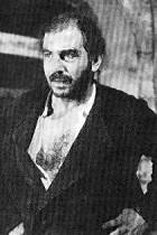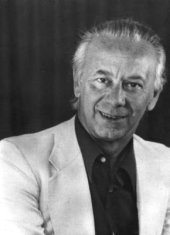|
|
Luciano Chailly (Composer) |
|
Born: January 19, 1920 - Ferrara, Italy
Died: December 24, 2002 - Milan, Italy |
|
The prominent Italian music administrator, teacher, and composer, Luciano Chailly, studied violin in Ferrara (diploma, 1941) and pursued academic training (literature) at the University of Bologna (B.A., 1943). After composition studies with R. Bossi at the Milan Conservatory (diploma, 1945), he studied with Paul Hindemith in Salzburg (1948).
Luciano Chailly grew up under fascism, but he himself remained essentially apolitical. He belonged to the era of postwar cinema, the age of Fellini, Antonioni and De Sica. Chailly was familiar with television and film: he produced for, and later headed, the music department of Radio Televisione Italiana (RAI) from 1951 to 19682 (or from 1950 to 19671). His music for Giacomo Vaccari's Il Mastro Don Gesualdo, after the novel by Giovanni Verga, brought him to a wider audience and he was the moving force behind the setting up of RAI's radiophonic archive in Milan. Chailly was artistic director of Milan's La Scala (1968-1971), Turin's Teatro Regio (1972), Milan's Angelicum (1973-1975), and Verona's Arena (1975-1976). He was again associated with La Scala (from 1977) and was artistic director of the Genoa Opera (1983-1985). He also taught at the Milan Conservatory (1968-1983). In 1989-1990 he was artistic director of the RAI orchestra and choir in Turin.
Luciano Chailly lived in Milan, but spent happy days at his family villa in Pievedi Ledro, near Lake Garda, where, revered as the local "maestro", he composed, swam and played tennis. He died in Milan in 2002 aged 82, His son is the conductor, Riccardo Chailly. He is also survived by his wife Anna Maria, whom he married in 1950, and two daughters, Floriana (a television producer) and Cecilia (a harpist). |
|
Music |
|
Like Ferruccio Busoni before him, Luciano Chailly drew inspiration from the Austro-German tradition. In Chailly's case, the chief influence was Paul Hindemith. Chaillyís music is composed in a communicative neo-Classical idiom, with some dodecaphonic incrustations and electronic effects. He tended to the middle ground, striving to reconcile mid-European tradition and note-row elements with the specifically Latin lyric strain "mixing dissonance with sweetness and elegance" that is found in Italian music from Rossini to Puccini. Chailly was never afraid to be eclectic, embracing 12-tone, tonal, bitonal and polytonal techniques, in a way that anticipated today's stylistic liberalism.
Luciano Chailly was a humanist. He served in World War II and reacted to its brutality. By 1968 his sympathies, albeit still Catholic (he composed two masses), sided with the Vietnamese resistance, as evidenced by his Liriche Della Resistenza Vietnamica (1974). Several other works reflect his feelings: the Kinder-Requiem (1977, an outburst against a wartime revenge killing of children in an Italian village); the Serenata A Mauthausen (1980); the ballet Anne Frank (Verona, 1981); and his De Profundis Di Cefalonia (1981, dedicated to 5000 fellow Italian soldiers massacred on the Greek island).
Luciano Chailly composed operas based on Chekhov, Dostoevsky and on Robert Louis Stevenson's Markheim (1967). He based four operas on the writing of his close friend Dino Buzzati, as well as his ballet Fantasmi al Grand-Hôtel (1961). Chailly described Sogno (Ma Forse No) (A Dream - Or Was It?), based on Pirandello, as "a key point in my development: precisely then (1972) I embarked on my third, 'deformalised' period". A successor to Hindemith-inspired neoclassicism and a free use of serialism, this luminous, expressive third phase Chailly likened to "sound hallucination".
In 1982, Luciano Chailly collaborated with Eugène Ionesco, setting to music his "anti-comedy" La Cantratice Calva (The Bald Prima Donna). This was staged by the Vienna Kammeroper in 1986 and revived recently at Paris's Opéra-Comique. His taste for the grotesquely ironic perfectly matched Ionesco's. Perhaps as important is the full-length opera La Riva Delle Sirti (The Shore Of The Syrtes), staged at Monte Carlo in 1959.
Also written for Vienna was Il Libro Dei Reclami (The Book Of Complaints, 1975), which Franco Ripa di Miena revived for Rome Opera's Teatro Nazionale in 2001. The USA premiere of Procedura Penale (The Mock Trial, 1959) was also staged in Florida that year. Between 1968 and 1983 Chailly was artistic director in turn of La Scala, Verona and Genoa opera houses.
Chailly loved poking fun. His appetite for experimentalism, inspired by Marinetti and dadaism, produced an intriguing short cantata, Tiadele-Mo (1965), based on African Pygmy texts, for baritone, choir and ensemble.
Luciano Chailly composed for strings, trumpet, percussion, mandolin, mouth organ and saxophone, and arranged Mozart's C minor Fantasia for three guitars. The ninth of his Sonate Tritematiche (Three-Themed Sonatas, 1951-1962) was converted into a ballet, Il Cappio (The Noose, 1962), in Naples. His orchestral work Sequenze Dell'Artide (Arctic Scenes, 1962) became another, Shee (1967), staged by the Australian Ballet in Melbourne. |
|
Works |
|
Dramatic:Operas:
Ferroatiasoprelevata (Bergamo, October. 1, 1955)
Una domanda di matrimonio (Milan, May 22, 1957)
II canto del cigno (Bologna, November 16, 1957)
La riva delle Sirti (Monte Carlo, March 1, 1959)
Procedura penale (Como, September. 30, 1959)
II mantello (Florence, May 11, 1960);
Era proibito (Milan, March 5, 1963)
L'Idiota (1966-67; Rome, February 14, 1970)
Vassiliev (Genoa, March 16, 1967)
Markheim (Spoleto, July 14, 1967)
Sogno (maforse no) (Trieste, January 28, 1975)
Illibro dei reclami (Vienna, May 29, 1975)
La Cantatrice calva (Vienna, Nov. 5, 1985)
Ballets:
Fantasmi al Grand-Hôtel (Milan, 1960)
II cappio (Naples, 1962)
L'urlo (Palermo, 1967)
Shee (Melbourne, 1967)
Anna Frank (Verona, 1981)
Es-Ballet (1983)
Instrumental:
Toccata for orchestra (1948)
12 Sonate tritematiche (for various instrumentations; 1951-1961)
Sequenze dell'artide for orchestra (1961)
Piccole serenate for Strings (1967)
Contrappunti a quattro dimensioni for orchestra (1973)
Newton-Variazioni for Chamber orchestra (1979)
Es-Konzert for orchestra (1980)
Psicosi for Instruments & Percussion (1980)
Es-Kammerkonzert for Small Instrumental Group (1983)
chamber works
piano pieces
Other:
Choral works
songs
music for television |
|
 
|
|
Sourcea:
1. Bakerís Biographical Dictionary of 20th Century Classical Musicians (1997)
2. Obituary in The Guardian (Author: Ginny Woodrow; February 10, 2003)
Contributed by Aryeh Oron (August 2011) |
|
Luciano Chailly : Short Biography | Arrangements/Transcriptions: Works | Recordings |
|
Links to other Sites |
|
Luciano Chailly (Official Website) [Italian] |
Obituary in The Guardian
Liciano Chailly (Music & Vision) |
|
Bibliography |
|
R. Cresti : Linguaggio musicale di Luciano Chailly. (Milan, 1993). |
|
|